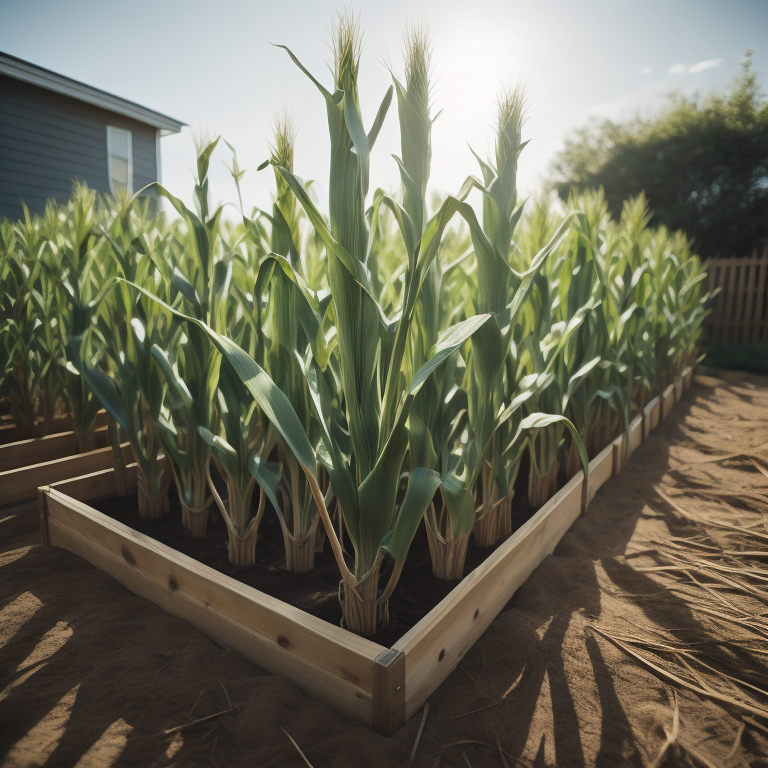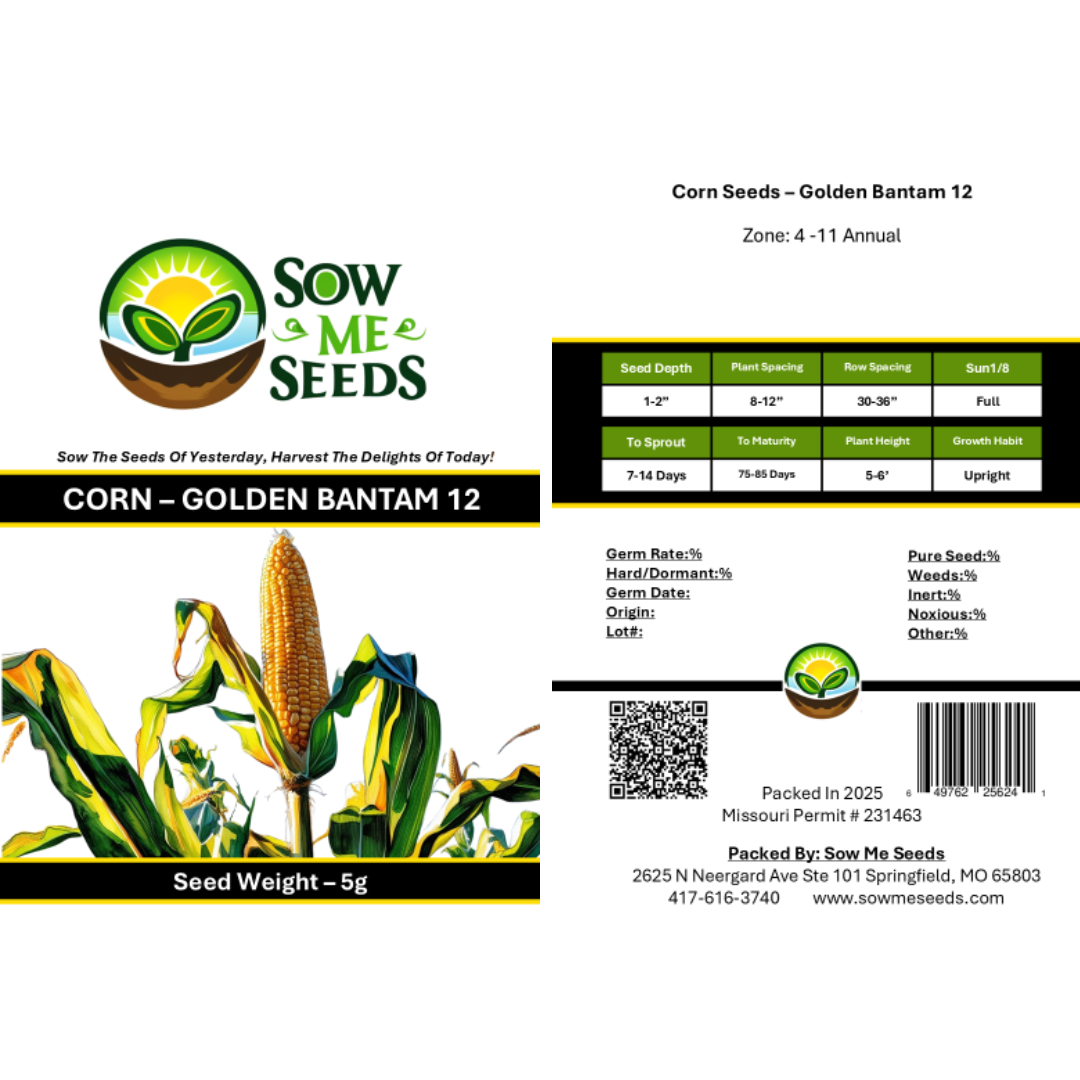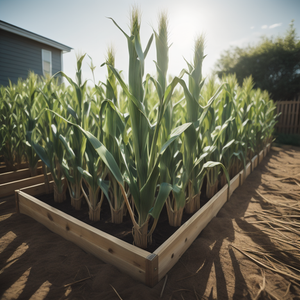- Hardiness Zone: 4-11 Annual
Seed Depth: 1–2 inches
Seed Spacing: 8–12 inches
Row Spacing: 30–36 inches
Sunlight: Full sun
Days to Sprout: 7–14 days
Days to Maturity: 75–85 days
Growth Habit: Upright
Sunlight: Choose a location that receives full sun for at least 6-8 hours a day. Corn thrives in warm, sunny conditions.
Soil: Prefers well-drained, fertile soil with a pH between 6.0 and 7.0. Amend the soil with compost or well-rotted manure to enhance fertility and drainage. Corn is a heavy feeder, so nutrient-rich soil is essential for a good harvest.
When to Plant: Corn is a warm-season crop that should be planted after the danger of frost has passed and the soil has warmed to at least 60°F (16°C). In cooler climates, you can start seeds indoors 3-4 weeks before the last frost date and transplant them outdoors after the soil has warmed.
Direct Sowing: Sow seeds directly in the garden 1-1.5 inches deep and 8-12 inches apart in rows spaced 30-36 inches apart. For optimal pollination, plant corn in blocks of at least four rows rather than in a single row.
Transplanting: If starting indoors, transplant seedlings outdoors when they are about 4-6 inches tall and the soil has warmed.
Watering: Keep the soil consistently moist but not waterlogged. Water corn regularly, especially during dry periods, to ensure even moisture. Corn needs plenty of water during the tasseling, silking, and ear development stages.
Fertilization: Corn is a heavy feeder. Apply a balanced fertilizer or compost at planting time. Side-dress with nitrogen-rich fertilizer when the plants are about 12 inches tall and again when they start to tassel. Mulch around the plants to retain soil moisture and suppress weeds.
Mulching and Weeding: Apply a layer of mulch around the plants to retain soil moisture, suppress weeds, and keep the soil temperature consistent. Hand-pull weeds carefully to avoid disturbing the shallow roots of the corn.
Pollination: Corn is wind-pollinated, so proper planting in blocks is essential for good pollination. If growing in a small garden, you can hand-pollinate by gently shaking the tassels to release pollen onto the silks.
Pest and Disease Management: Corn can be susceptible to pests such as corn earworms, cutworms, and aphids. Use organic pest control methods like neem oil, insecticidal soap, or hand-picking to manage infestations. Practice crop rotation and ensure good air circulation to prevent fungal diseases like rust and smut.
When to Harvest: Golden Bantam 12 Sweet Corn is typically ready to harvest 70-85 days after planting. Harvest when the silks have turned brown and dry, and the kernels are plump and milky when pierced with a fingernail.
How to Harvest: To harvest, hold the ear firmly and twist it downward to snap it off the stalk. For the best flavor, harvest in the morning and refrigerate the ears immediately if not eating them right away.
Storing Fresh Corn: Freshly harvested corn can be stored in the refrigerator for up to a week. For longer storage, corn can be blanched and frozen, or the kernels can be canned or dried.
Why You’ll Love It
Heirloom Favorite: An improved version of the original Golden Bantam with larger ears and better spacing.
Rich, Sweet Flavor: Full-bodied taste that’s sweeter than standard field corn.
Fast Maturing: Earlier harvest means more flexibility for succession planting.
Great for Home Preservation: Holds its flavor when frozen or canned.
Plant Characteristics
Height: 5–6 feet
Growth Habit: Upright stalks with one to two ears per plant
Ear Type: 6–7 inch ears with 8–12 rows of bright yellow kernels
Days to Maturity: 75–85 days
Hardiness: Warm-season annual
Flavor and Culinary Uses
Flavor: Sweet, buttery, and slightly nutty — classic corn flavor with a rich finish
Culinary Uses: Delicious fresh on the cob, grilled, steamed, frozen, or canned for later
Companion Planting Tips
Good Companions: Pole beans, squash, cucumbers, and sunflowers
Avoid Planting Near: Tomatoes or brassicas (can compete for nutrients)
Bonus Benefit: Ideal for Three Sisters-style companion planting with beans and squash
Common Issues and Solutions
Poor Pollination: Plant in blocks rather than single rows for fuller ears
Corn Earworms: Use corn collars or mineral oil on silks to deter pests
Stunted Growth: Ensure full sun, warm soil, and consistent watering
Seeds Per Packet
| 5g | Approximately 20 |
| 20g | Approximately 80 |
Why You’ll Love It
Heirloom Favorite: An improved version of the original Golden Bantam with larger ears and better spacing.
Rich, Sweet Flavor: Full-bodied taste that’s sweeter than standard field corn.
Fast Maturing: Earlier harvest means more flexibility for succession planting.
Great for Home Preservation: Holds its flavor when frozen or canned.
Plant Characteristics
Height: 5–6 feet
Growth Habit: Upright stalks with one to two ears per plant
Ear Type: 6–7 inch ears with 8–12 rows of bright yellow kernels
Days to Maturity: 75–85 days
Hardiness: Warm-season annual
Flavor and Culinary Uses
Flavor: Sweet, buttery, and slightly nutty — classic corn flavor with a rich finish
Culinary Uses: Delicious fresh on the cob, grilled, steamed, frozen, or canned for later
Companion Planting Tips
Good Companions: Pole beans, squash, cucumbers, and sunflowers
Avoid Planting Near: Tomatoes or brassicas (can compete for nutrients)
Bonus Benefit: Ideal for Three Sisters-style companion planting with beans and squash
Common Issues and Solutions
Poor Pollination: Plant in blocks rather than single rows for fuller ears
Corn Earworms: Use corn collars or mineral oil on silks to deter pests
Stunted Growth: Ensure full sun, warm soil, and consistent watering
Seeds Per Packet
| 5g | Approximately 20 |
| 20g | Approximately 80 |




Share and get 15% off!
Simply share this product on one of the following social networks and you will unlock 15% off!